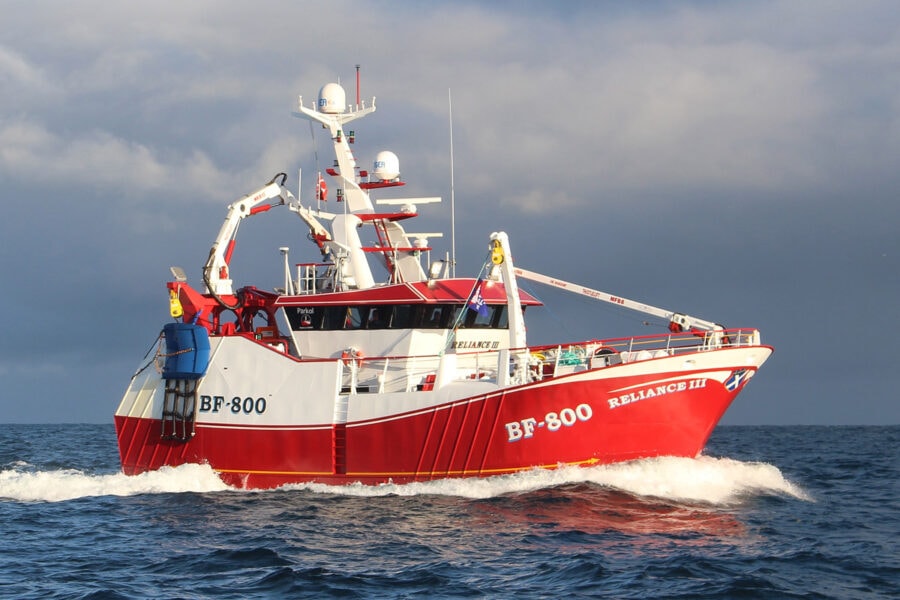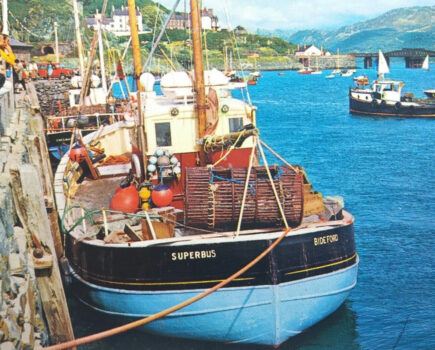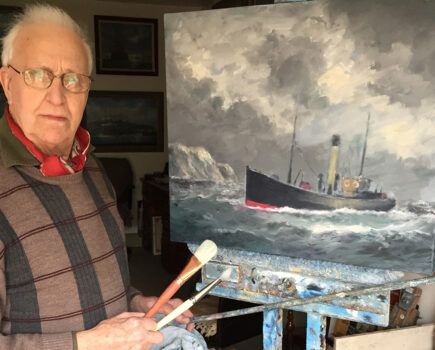Banff father and son skippers take delivery of Whitby-built twin-rig trawler
Built by Parkol Marine Engineering for skippers John and David Clark, the new 20.4m dual-purpose prawn and whitefish twin-rig trawler Reliance III BF 800 sailed from Fraserburgh towards the end of last week to fish her maiden trip on the North Sea grounds, reports David Linkie
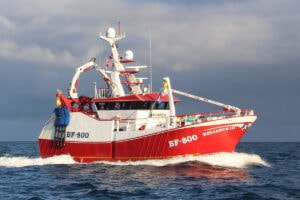
01. Reliance III approaching Fraserburgh at the end of a 24-hour passage north from Whitby.
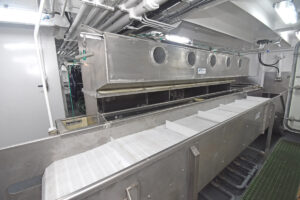
02. General view of the integrated dual-purpose fish and prawn catch-handling system supplied by Seagate Fabrication.
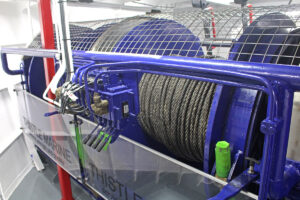
03. A new design of three-barrel trawl winch featuring safety guards and hydraulically operated brakes was part of the full package of deck machinery manufactured by Thistle Marine.
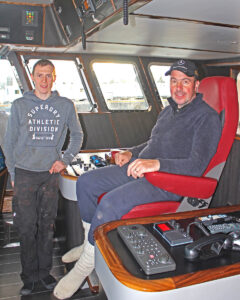
04. Reliance III skippers John and David Clark.
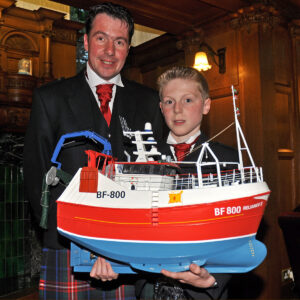
“05. David Clark in 2009, proudly holding a scale replica of the boat he would go on to skipper.”
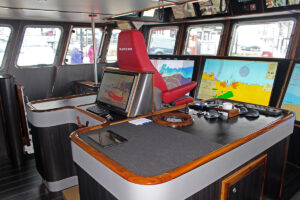
06. General view of the wheelhouse.
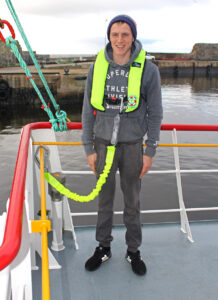
07. David Clark demonstrates the personal harnesses that are clipped onto a continuous safety rail around the shelterdeck.
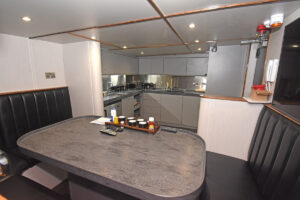
08. The messdeck/galley extends the full length of the deck house to starboard.
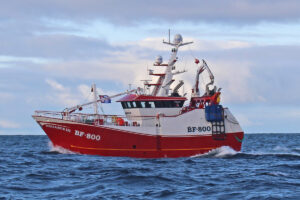
09. Reliance III is the first of a new design of vessel from Parkol Marine Engineering.
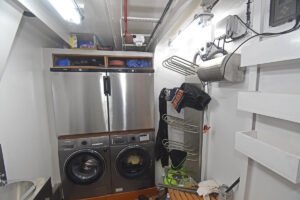
10. Laundry facilities are included in the crew changing room.
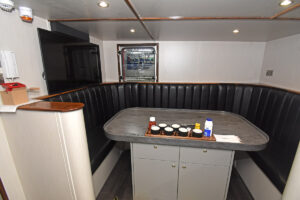
11. The messdeck.
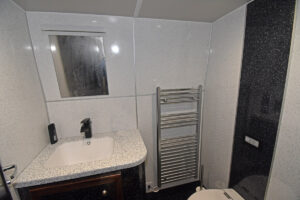
12. The shower and WC compartment.
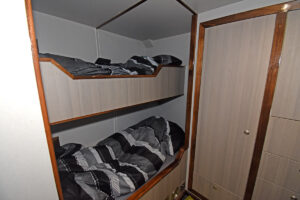
13. Two of the bunks in the four-berth cabin arranged to port…

14. … of the walk-in compartment housing the Wills Ridley steering gear.
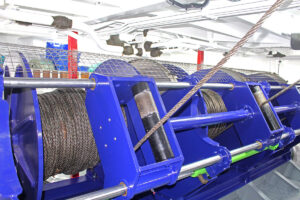
15. The bespoke two-speed 33t core-pull three-drum trawl winch manufactured by Thistle Marine…
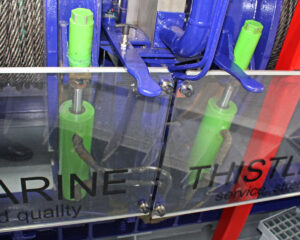
16. … features hydraulically operated brake cylinders.
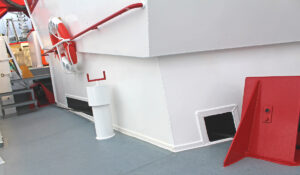
17. The outer trawl wires are led under the forward corners of the wheelhouse.
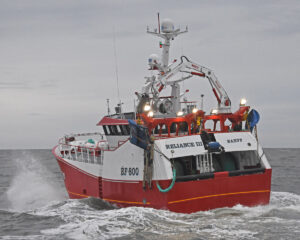
“18. Port quarter view of Reliance III, showing working arrangements across the transom.”
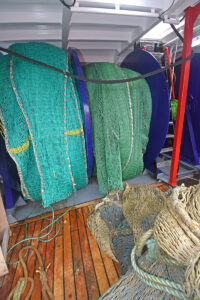
19. John and David Clark made three sets of fish and prawn twin-rig scraper nets themselves.
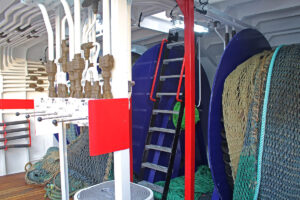
20. Two sets of split net drums are operated from centrally located controls.
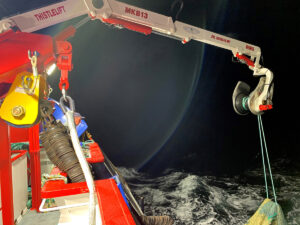
21. Using the Thistlelift MKB13 powerblock crane mounted to starboard atop the trawl gantry to lift out the starboard trawl.
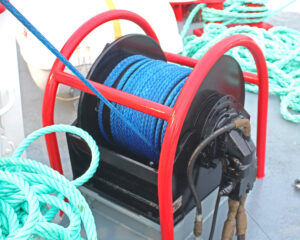
22. A 7.5t Gilson winch is used to take the codends aboard.
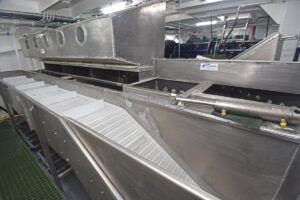
23. Catches are selected from a conveyor leading across the full beam of Reliance III.
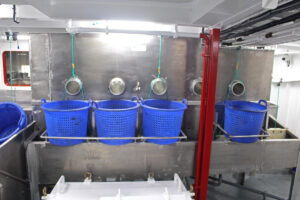
24. Baskets for the selections passed through the circular chutes are placed above the troughs into which fish from the four integrated washers are released.
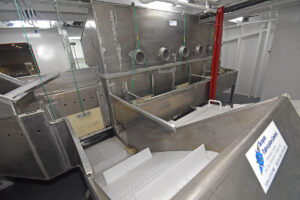
25. A second elevated conveyor moves fish forward for delivery to the fishroom.
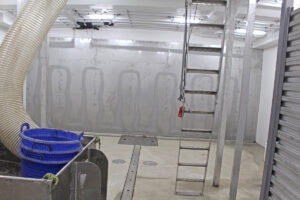
“26. The 1,000-box-capacity fishroom is fitted with deck and bulkhead chilling installed by Premier Refrigeration.”
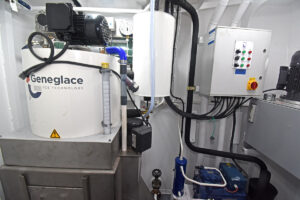
“27. A Geneglace flake ice machine is housed in a walk-in compartment on the port side of the main deck, along with some of the fishroom chilling equipment.”
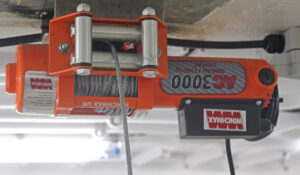
28. An electric winch is used to pull stacks of boxes forward to the hatch when landing.
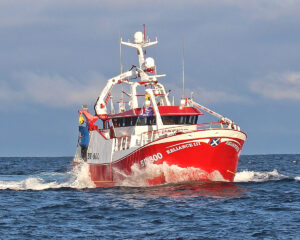
29. Bow view of Reliance III.
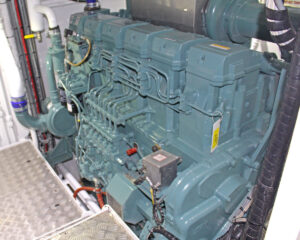
“30. The Mitsubishi S6R2 T2-MPTK-3 engine develops 555kW @ 1,350rpm.”
Taking delivery of Reliance III was a case of déjà vu for John and David Clark, albeit from slightly different perspectives, as when Parkol launched Reliance II BF 800 for skipper John Clark in 2009, his son David was a 12-year-old boy wide-eyed with excitement, not least at the evening function when holding the scale model of a boat he would go on to skipper.
Fast-forward 11 years, and today David is a fully fledged skipper, having learned every aspect of the job under the ever-watchful eye of his father on Reliance II. Earlier this year he won the Fishing News Young Fisherman of the Year award.
At a time when young skippers are as important for the future of the fishing industry as fishing opportunities and quotas, it is highly encouraging to see yet another example of family tradition being continued by the next generation.
Working through United Fish Selling Ltd of Buckie, with which John Clark has a lifelong association, Reliance III is expected to work six- to eight-day trips, fishing in a seasonal arc across the top of Scotland, ranging from Rockall east to Orkney, Shetland and the North Sea grounds.
Fraserburgh, Scrabster and Macduff are expected to be the main ports of landing relative to the areas being fished, with catch being put ashore in boxes supplied by Box Pool Solutions Ltd.
A number of local Fraserburgh and Peterhead companies, including Blue Anchor Fire and Safety, Box Pool Solutions, Faithlie Trawl, Jackson Trawls, PBP Services, Premier Refrigeration, Scanmar UK, Seagate Fabrication, Strachan Trawls and Woodsons, supplied equipment and fishing gear to Reliance III.
Built to a new round bilge hull design, plans for which were drawn up by Ian Paton of SC McAllister & Co Ltd, Reliance III has main dimensions of LOA 20.4m, registered length 16.49m, beam 7.7m, moulded depth 4.55m, draught 5.2m and GT 185t.
The advances in hull design and propulsion technology developed in the past decade are shown by the fact that while Reliance III has a registered length of 16.49m, the same as her predecessor, the LOA, beam and draught of the new build have increased by 1.4m, 0.7m and 0.6m respectively. The propeller diameter has increased by 32% from 1,900mm to 2,500mm, while the reduction ratio of the gearbox is 22% higher at 7.476:1 compared to 6.12:1.
In addition to the new hull design, Reliance III features several innovative ideas that skipper John Clark suggested to enhance crew safety. These include a dedicated second rail running around the shelterdeck to which crewmen can clip their safety harnesses when working on the top deck.
Customised safety guards are fitted above each barrel of the three-drum winch, which was manufactured by Thistle Marine. It is also fitted with hydraulically operated brake cylinders that can be operated from the trawl console in the wheelhouse.
Shortly before leaving Whitby for Fraserburgh, skipper John Clark said: “Delivering Reliance III on time despite the Covid-19 situation is a fantastic achievement by the Parkol team. Building a new boat during a lockdown situation, when initially everything stopped, was a new and very strenuous experience for everyone concerned.
“By implementing three daily shifts over the course of 18 hours to maintain social distancing, as soon as possible and throughout the fitting-out process, and putting in place strict testing and hygiene requirements as laid down by UK government regulations, the yard ensured that Reliance III was launched and ran sea trials in line with the schedule agreed long before the pandemic started. Huge credit and sincere thanks to everyone who adjusted their working patterns to make this possible.
“Big thanks also to Alan Smith from the Royal Bank of Scotland, who assisted me every step of the way when building Reliance II, and now Reliance III. His help and advice was very much appreciated once again.
“Reliance II was a superb boat, the consistent performance of which stood us in good stead for 11 years and therefore made the new build possible. Designing a better boat was a difficult task for Ian Paton, but the initial signs are that he has achieved exactly that.
“In terms of seakeeping qualities, working arrangements, towing capabilities, fuel economy and quiet running, Reliance III performed well on fishing trials, conducted in less than favourable conditions. Greater challenges doubtless lie ahead during the coming winter months, which we are confident the boat will meet head on.
“When we started to discuss a new boat, many of the major decisions dropped into place immediately. The Mitsubishi main and auxiliary engines on Reliance II gave sterling performance throughout, as did the Thistle Marine deck machinery, so there was no hesitation in going with the same again. Similar thinking applied to designer and boatyard.
“While the hull design is significantly different, together with the size of the stern gear, Reliance III is intended to replicate the fishing capabilities of her predecessor, while giving greater working flexibility.
“The level of build quality, machinery installation and internal finish speaks volumes for the Parkol team.
“With Brexit still to be finalised, new regulations on whitefish nets scheduled for next year, and coronavirus continuing to impact on marketing, particularly in the prawn sector, this is an extremely challenging time to be taking on a new boat – although in the past 20 years, has there ever been such a thing as a good time?
“As with any business, fishing is competitive, and if you don’t have the right tools for the job, you can quickly drop astern. With Reliance III, we are as confident as we can be that we are well placed to meet whatever the future holds.”
During the design process, particular consideration was given to the bow and underwater stern sections, from the differing perspectives of achieving maximum deck space forward, load-carrying and vessel trim throughout a trip, and propulsion efficiency and seakeeping qualities. The result is a full bulbous bow and fine waterline entry, above which there is a considerably concave raked stem and strongly flared bow section, to ensure that the vessel’s beam of 7.7m is carried well forward, while the aft lines sweep up to the transom.
When the hull design was finalised, Deri Jones & Associates generated the cutting information, which was then transferred to Holland for cutting and forming of the double-curvature shell plating, for subsequent delivery by road to Whitby, where fabrication work began 11 months ago.
General arrangements
Reliance III features a generally conventional layout for this type of vessel.
Below the main deck, the hull is divided into forepeak, fishroom, engineroom and accommodation cabin. The latter is neatly arranged to give two twin-berth cabins along the starboard side and a four-berth cabin to port. A walk-in central compartment houses the Wills Ridley steering gear.
Under the full-length shelterdeck, a central passageway in the deck casing connects the forward catch-handling area to the quarter. Heated storage for deck clothing is arranged in the forward port corner of the deck house, together with bench seating and hand-washing facilities. Clothes-washing and tumble-drying facilities are also housed in this area.
A large shower/washroom is also located to port of the open central area of the deckhouse, which also gives access to the wheelhouse, cabins, engineroom and galley.
Arranged along the full starboard half of the deck house, the immaculately finished combined galley/messdeck is equipped with the usual range of modern electrical appliances.
All internal accommodation areas on Reliance III are finished to an extremely high standard, using a combination of solid timber and colour-co-ordinated modern materials to give an attractive and homely look.
A walk-in compartment housing the fishroom refrigeration machinery, together with a 1t Geneglace flake ice machine, is situated on the port side of the main deck.
Twin-rig trawling arrangements
The full package of deck machinery and hydraulics installed on Reliance III was custom-designed, manufactured and commissioned by Peterhead specialist Thistle Marine Ltd. Having had 11 years of consistently reliable performance from a similar set of deck machinery on Reliance II, skipper John Clark had no hesitation in entrusting Thistle with supplying bespoke deck machinery for the new build.
Twin-rig trawling duties are carried out by a large three-drum trawl winch positioned forward on the main deck. Rated 33t core pull, the heavy-duty winch is fitted with two-speed drive motors for faster hauling and shooting of the wires. The winch barrels are spooled with 250 fathoms of 20mm- and 22mm-diameter (middle) Bridon Dyform trawl wire, supplied by Jackson Trawls of Peterhead.
As a result of discussion between skipper John Clark and Jim and Jason Clark of Thistle Marine, the trawl winch incorporates two interesting firsts for this class of vessel.
To eliminate the risk of anyone accidentally coming into contact with either the wire or revolving drums, steel guard covers are fitted over each of the winch barrels.
The second innovation is that the winch brakes are operated by hydraulic cylinder, rather than mechanically. This gives the big advantage of enabling the skippers to brake the drums remotely from the trawl console in the wheelhouse. The dual braking system also allows the brakes to be operated by the winchman.
Led up from the drums at nearly 35° to hooded rollers, the three warps have parallel runs across the top of the shelterdeck to the foreside of the wheelhouse. In a new arrangement, following the owners’ request for a wider wheelhouse, the outer wires run under the forward corners of the wheelhouse before emerging through elongated slots on the port and starboard sides, from where they have straight leads to hanging blocks mounted on a conventional trawl gantry.
After passing under the wheelhouse floor, the middle wire leads upwards to run through a hanging block mounted on the underside of the trawl gantry, directly above a secure box for the safe storage of the middle roller.
The customary hardwearing UHMW-PE sheathing panels and strips are secured to outer hull areas in line with where the trawl doors and middle roller are worked, to minimise abrasion, wear and paint discolouration.
Two sets of 2 x 12.5t split net drums are arranged side by side on the hardwood-decked quarter, in line with the transom shooting and hauling hatches, the lower edges of which are fitted with large-diameter free-turning rollers.
A 1.6t @ 6.4m kinked-boom crane, fitted with a Thistle 24in W-sheave powerblock, is offset to starboard atop the trawl gantry.
The codends are taken aboard forward on the starboard side by a 7.5t Gilson winch, mounted forward of a single-leg lifting post arranged over a hydraulically operated hatch and a 200-box-capacity reception hopper.
All the necessary Flemings Fairleads hanging blocks and deck rollers were manufactured by F&R Belbin of Tynemouth.
Catch-handling
The layout and working arrangements in the catch-handing area forward of the deck casing are customised to the owners’ specific requirements.
At the heart of the working arrangements is a fully integrated aluminium and stainless steel fish-handling system, designed and fabricated by Seagate Fabrication, Peterhead to accommodate both prawns and whitefish while enhancing catch quality and reducing the crew’s workload.
A transverse conveyor lifts catches from the base of the hopper and across the full beam of the vessel. After being selected and gutted, the main selections of fish are either placed into one of four elevated bins, or directly into the four separate washers positioned below the bins. After washing, the selections flow on to a second elevated conveyor positioned towards the starboard side, for delivery to the fishroom for boxing.
Prawns (or whitefish) are placed into one of five circular chutes passing through the raised bins, before dropping into baskets secured on platforms above the receiving trough positioned forward of the fish washers.
The catch-handling area is kept free of excess water from the fish washers by two deck sumps drained by electrically driven Azcue pumps.
On delivery to the starboard side of the fishroom, catches are electronically weighed, with part-basket weights stored on the vessel’s VCU catch management system, before a label displaying all relevant information, including species, grade, size, time and date, is printed off and affixed to the end of the corresponding box. This information is also transferred automatically to a PC in the wheelhouse, where it is accumulated to provide a running total of Reliance III’s trips.
The vessel’s fishroom has a working capacity of some 1,000 boxes, supplied by Box Pool Solutions Ltd. Seven hundred and twenty-four boxes, stacked 12 high, can be carried aft of the deck hatch. Up to 4t of flake ice can be stored in full-height wing lockers arranged to port and starboard.
For the first time on a new vessel built at Whitby, the fishroom was extensively insulated and GRP-lined by PBP Services Ltd, Fraserburgh, to ensure optimum levels of catch quality and hygiene.
The fishroom chilling system, which uses 22mm-diameter stainless steel refrigeration pipes mounted on the deckhead, and stainless steel-sheathed copper piping on the engineroom bulkhead, was installed by Premier Refrigeration Ltd. The Fraserburgh specialist also supplied the Geneglace 1t flake ice machine.
Automatically controlled from the wheelhouse and set to the required temperature by a digital thermostat, the cooling plant comprises a Bock compressor, an Azcue water pump driven by a three-phase electric motor, and a Blitzer seawater condenser.
Catches are discharged from the fishroom using a Thistle MFB8 1t x 8m straight-boom crane fitted with a 1t landing winch.
Engineroom
Describing the Mitsubishi engines that gave sterling service for 11 years on Reliance II as ‘bullet-proof’, skipper John Clark understandably opted for the same again on Reliance III.
The main and two auxiliary Mitsubishi engines were supplied by Padmos of Stellendam, thereby further strengthening the Dutch company’s association with Parkol Marine Engineering.
Developing 555kW @ 1,350rpm, and solely dedicated to propulsion duties, the main engine drives a 2,500mm-diameter four-bladed fixed-pitch Teignbridge propeller turning in a modern high-thrust, low-drag nozzle, fabricated by the yard, through a Reintjes WAF 474 gearbox with a reduction ratio of 7.476:1.
Engine and fishing trials demonstrated encouraging results with the stern gear, which was machined by Premier Engineering of Scarborough and is fitted with Lip Seals, delivering a very smooth and quiet performance in all operating modes, and strong towing.
The centreline combination, together with a single rudder, gave Reliance III an average top speed of 9.6 knots on sea trials.
When initially towing the scraper nets at 1,050rpm – the engine speed predominately used on Reliance II – her successor was using 83 litres of fuel per hour in covering the ground at 3.8-4.2 knots. On reducing the towing speed to the usually preferred 2.8-3 knots, the main engine was running at 850rpm and using 62 litres an hour.
A Mitsubishi 6D24TC auxiliary engine (181kW @ 1,500rpm), mounted on the port tank top, powers the deck machinery hydraulics through a PF 120 gearbox and splitter box.
An electrically driven 22kW power pack is used to drive a hydraulic towing pump, as well as provide back-up hydraulic power. This arrangement also enables the deck machinery to be operated in harbour, when the crew are mending or taking on gear while routine maintenance is carried out on the main engine.
Installation of the vessel’s hydraulic system was completed in-house by Parkol Marine Engineering, with stainless steel piping being used throughout.
Electrical supplies on Reliance III are provided by two 140kVA Leroy Somer 415/3/50 generators. One of these units is driven by the second Mitsubishi auxiliary engine, a 6D16 unit developing 105kW @ 1,500rpm, while the other is mounted at the front engine of the larger hydraulic auxiliary engine.
Cooling for all three engines and the hydraulic system is provided through NRF box coolers arranged across the forward end of the engineroom. Cunife steel piping is used extensively throughout the engineroom.
A Sonic 8 hull ultrasonic generator, supplied by NRG Marine, is installed in the engineroom, in order to eliminate the regular occurrence of sea chests/sea valves and piping becoming choked with mussels, which in turn reduces the supply of water going to a vessel’s cooling systems and the fishroom refrigeration plant.
One Victron 80-amp charger is fitted to charge the three sets of batteries in the engineroom. A similar Victron charger is situated in the wheelhouse to serve the lighting batteries, in addition to a 50-amp GMDSS charger.
Pearson Electrical of Hull was subcontracted by Parkol Marine Engineering to undertake the electrical installation work on Reliance III alongside the boatyard’s own electricians.
A combination of four wing tanks in the engineroom and two under the fishroom floor enable Reliance III to leave port with 24,000 litres of fuel. The tank arrangement enables fuel to be transferred in order to maximise vessel trim during the course of a trip. Freshwater capacity is 20,000 litres, split between a 14,000-litre forepeak tank and two 3,000-litre double bottom tanks below the fishroom.
Compiling this feature would not have been possible without the help of friends, who yet again went that extra mile and more to provide support and help offset the Covid-19 situation. Sincere thanks to all.
Customised wheelhouse layout includes quad video wall
Reliance III features a customised wheelhouse layout designed to skipper John Clark’s requirements, in liaison with the yard and Woodsons, which supplied and installed the electronics equipment.
All modes of fishing and navigation operations are displayed through a quad view video wall arranged across the front of the wheelhouse, in which preferred screen displays from the main items of electronic equipment are shown on three 55in 4K bridge monitors.
A wide range of split-screen viewing arrangements, from single to 16 images, can be selected using the integrated control system.
An iPad app also enables skippers John and David Clark to select the preferred screen arrangement for the prevailing mode of operation.
A further 11 Neovo X24 wide screens, controlled through an eight by eight-way HDMI digital matrix switcher unit, are positioned two at either side of the overhead console, in two tiers of three, at the trawling station and at the office desk.
A single NorSap skipper’s chair, supplied by Crown Seating, is centrally positioned, flanked by two elongated island units on which the communications equipment, main radar controls and control trackball are arranged.
Two slimline steering pods are located at the forward corners of the wheelhouse, directly below two 19in monitors displaying images from cameras mounted on the wheelhouse roof overlooking the port and starboard sides of Reliance III. These provide the skippers with full visibility when they are manoeuvring the vessel in confined areas.
The aft-facing trawl console is centrally positioned between the starboard wheelhouse door and the accommodation trap.
The use of rich walnut mouldings, together with light and dark grey laminates and matching plank-effect flooring, gives an extremely eye-pleasing modern look to the interior of the spacious wheelhouse. A large CNC-profiled plaque depicting Reliance III and the boatyard’s logo, positioned at the foreside of the accommodation trap, adds a nice touch.
Bottom-sounding duties on Reliance III are handled by a Hondex HE7300 dual-frequency (50kHz/200kHz) colour sounder.
Details of the vessel’s location are processed by two Furuno GP39 GPS receivers, and heading is provided by a Comnav G2 GPS gyrocompass. Positioning data received is interfaced to an Olex 3D seabed mapping system and a Sodena Easywin plotting system, which support tidal data, AIS and ARPA tracking.
The JRC JMA 5212-6 main radar is backed up by a JRC JMA 5204 unit. Both BB radars are interfaced to a Jotron Class A AIS transceiver and, with ARPA, provide tracking through the Olex and Sodena plotters.
Steering and navigation is taken care of by a Navitron NT921 Mk II digital autopilot with duplicate levers at the forward wing consoles and aft at the trawling station.
Communications and safety equipment include a JRC JSS-2150 MF/HF GMDSS SSB radio telephone, Sailor and Icom DSC VHFs, Entel HT649 GMDSS handheld VHF, and JRC Navtex receiver.
Woodsons also installed a comprehensive CCTV system, with 16 HD cameras and a propeller camera providing the skippers with a live view of the propeller.
Scanmar twin-rig monitoring system
Reliance III skippers John and David Clark continue to use the ever-popular Scanmate SS4 Double Distance monitoring system to provide optimum levels of fishing efficiency, in terms of both gear spread and fuel economy.
Information supplied by three Scanmar SS4 sensors operating via the ScanMate bridge system provide constant numerical and graphical updates of where the clump is in relation to the trawl doors via the Extended Distance function. Historic data can be logged and tracked in relation to vessel position for closer monitoring during tows.
In a fishery where maximising gear spread and symmetrical net geometry is of paramount importance, this information enables the position of the clump to be adjusted whenever the need arises, by eliminating any doubt from the mind of the skipper as to whether the clump is in line with, in front of or behind the trawl doors.
The Scanmar QBC-X1 smart charger allows the skipper to increase or decrease source level on all three sensors, giving a battery life of up to two months between charging.
Extensive package of fishing gear
Reliance III will use a variety of twin-rig prawn scraper/hopper trawls and whitefish nets made in northeast Scotland.
John and David Clark made three sets of fish/prawn twin-rig scraper nets themselves, including 2 x 200ft and 2 x 270ft nets rigged on 6in and 8in discs, and 2 x 240ft nets with 10in discs in the bosom section.
Strachan Trawls of Fraserburgh supplied 2 x 240-fathom fish scraper twin-rig trawls rigged on 6in-, 8in- and 10in-diameter discs.
When the new regulations that will apply for whitefish nets from 1 January, 2021 are known, Fraserburgh netmaker Faithlie Trawl will make two 120ft high-standing whitefish twin-rig fish nets rigged on 12in and 14in ground gear.
Reliance III usually works 70-fathom sweeps comprising 10 fathoms of 22mm-diameter wire rubber legs, 40 fathoms of 32mm-diameter four-strand combination warp and 20 fathoms of heavy 26mm wire to connect the twin-rig gear to a 1,200kg middle roller, made by Macduff Shipyards Ltd, and a set of Thyborøn Type 72 3m2/750kg trawl doors.
Jackson Trawls of Peterhead supplied 3 x 250-fathom lengths of 20mm and 22mm (middle) Bridon Dyform trawl wire.
The lazy pennants and associated trawl chandlery, along with the 26mm wire sweeps, came from Seaway Nets, Macduff.
Going forward with Reliance III
Taking Reliance III into Fraserburgh harbour, and subsequently into their home port of Macduff, for the first time were poignant moments for father and son skippers John and David Clark and their family.
Although they lived in the highly fishing-dependent village of Whitehills, three miles west of Macduff, John Clark’s family had no prior involvement with fishing before he enrolled for the YTS fishing scheme in 1988. His first berth was on George Pirie’s Chrisona BF 130, who was pair-trawling from Kinlochbervie with his brother James, who had Achieve BF 223.
Two years later, John Clark got a berth with skipper Bob Hepburn on Chelaris BF 16, initially pairing with Tranquility BF 7 and later with Reliance BF 80.
When Bob Hepburn sold Chelaris and bought the rebuilt Shamal BF 16 (ex Jaseline), John Clark made the same transition and started twin-rigging for fish and prawns.
In 1993, John Clark was offered the chance to buy into Reliance by skipper Willie Milne – an opportunity he readily accepted.
The 18m wooden-hulled Reliance BF 80 was built by Macduff Boat Building & Engineering Co Ltd in 1988 as a seine-netter for local skippers William Paterson and William Milne, as a replacement for Glen Alvah BF 66.
Perhaps not without coincidence, during his last year at Banff Academy in 1987, John Clark and his pals would skip school, take the bus to Macduff and slip into the wooden boat-building shed at the west end of the harbour where Reliance was under construction.
John Clark said: “It’s funny how things turn out. At the time, I never thought I’d become skipper/owner of a boat we followed the construction of at every opportunity. I have never looked back and regretted the career I picked.”
After a new Mitsubishi engine and gearbox were installed in 2001, replacing a Kelvin 328kW six-cylinder main engine, Reliance performed consistently well twin-rig trawling for prawns and whitefish by-catch, usually fishing well north of Fraserburgh.
In 2008, skipper John Clark took the decision to have the 19m steel-hulled twin-rig trawler Reliance II BF 800 built by Parkol Marine Engineering.
As Reliance II was nearing completion at Whitby, her predecessor, the results from which made the new build possible, moved south to Hartlepool after being bought by Major Hartley.
A similar pattern of southward movement occurred 11 years later, when Reliance II, which regularly fished the Rockall grounds on a seasonal basis, was bought by Devon owner Waterdance Ltd.
As Reliance III left Whitby earlier this month, her predecessor was being converted for whelk potting by Parkol Marine Engineering. Work included fabricating a hauling hatch at the starboard shoulder, and fitting fishroom delivery chutes, a Ziegra ice machine and a Mitsubishi 6D16 auxiliary engine after all the trawl machinery was removed.
Now renamed Kelly of Ladram BM 800, the whelker is expected to start fishing from Brixham next month, skippered by Tom Rainbird.

